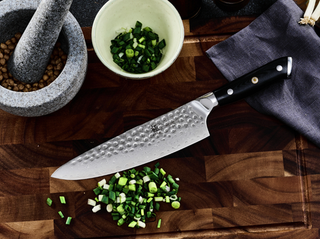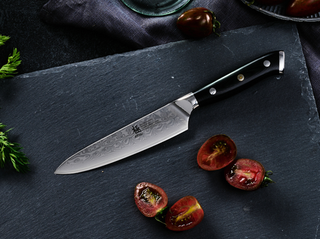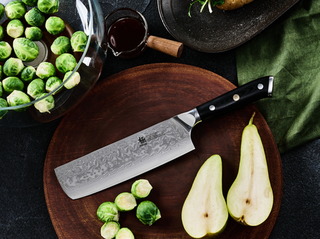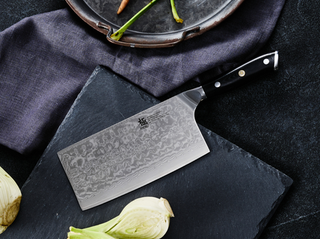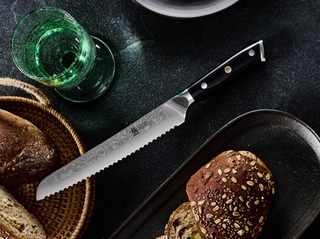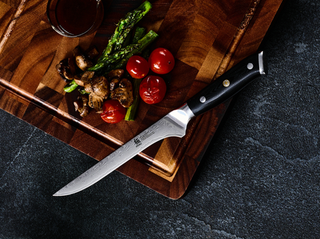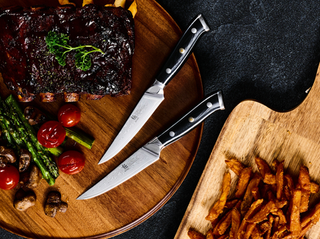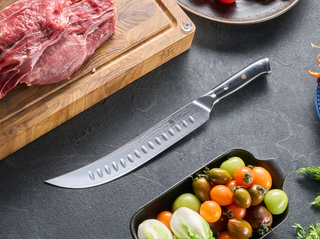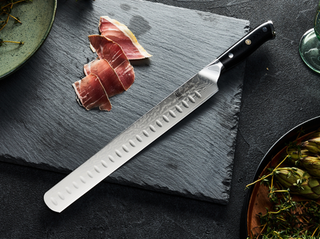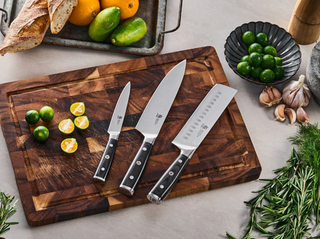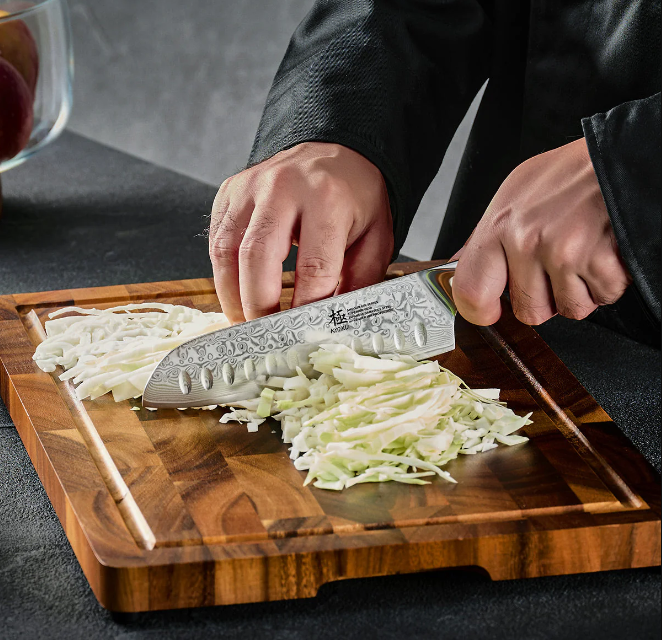A Santoku knife can be used in a lot of different ways in both home and professional kitchens. Japanese in origin, "Santoku" means "three virtues," which shows that it can slice, dice, and mince. The goal of this guide is to help you pick the best Santoku knife, emphasizing the materials that can make the Santoku knife work differently.
What are Santoku Knives Made of?
When trying to choose the best Santoku knife, the material is an important factor that you need to consider. It affects everything from how long the blade lasts to how often it needs to be sharpened. Take a better look at the main materials of Santoku knives.
1. Ceramic

Advantages: Ceramic is an extremely hard material, which makes it possible for blades to have superior sharpness. It can stay sharp for a long time and won't rust. Besides, it doesn't make food taste metallic. It is great for cutting fruits and vegetables.
Disadvantages: Ceramic's hardness makes it difficult to sharpen with standard tools. Typically, it requires professional service. It is also brittle and a drop can easily crack or chip the blade.
2. Carbon steel
Advantages: Carbon steel is characterized by a higher carbon content than ordinary steel, so its main advantage is its exceptional sharpness and edge retention. It is also relatively easy to sharpen compared to harder steels.
Disadvantages: The downside to carbon steel is its susceptibility to oxidation. It rusts easily if not properly cared for. It requires regular maintenance, including drying after each use and periodic oiling to prevent rust.
3. Alloy steel
Advantages: This category includes a variety of steels that are formulated with additional elements like chromium, molybdenum, and vanadium, which can enhance their properties. Common types include VG10, which is considered high-carbon stainless steel due to its carbon and chromium content, offering a good balance of sharpness and rust resistance. Damascus steel is also known for its distinctive layered appearance and combines hard and soft steels to offer durability along with fine sharpness.
Disadvantages: The main drawback of alloy steels is their cost. These materials are typically more expensive to produce, especially in high-quality forms like Damascus. Additionally, some alloy steels can be not easy to sharpen due to their hardness.
Performance Comparison
1. Sharpness: ceramic knives > carbon steel knives > alloy steel knives
2. Rust resistance: ceramic knives > alloy steel knives > carbon steel knives.
Ceramics undoubtedly will not rust. Alloy will generally undergo anti-rust treatment, so they usually will not rust after usual cleaning. Carbon steel knives require careful care.
3. Retention: ceramic knives > carbon steel knives > alloy steel knives.
Retention is determined by the hardness of knives. The higher the hardness, the less likely to become blunt.
Generally speaking, for daily families, alloy steel outperforms the other two.

Other Factors that Influence the Performance of Santoku Knives
While the material of the blade is a critical factor in the performance of Santoku knives, several other elements also play significant roles.
1. Blade Geometry: The blade's shape can influence how it cuts different things. A good blade shape can make cutting easy and keep food from sticking. The edge of a Santoku knife is usually flatter than the edges of other cooking knives. This makes it great for precise cutting.
2. Handle Design and Ergonomics: How comfortably and firmly you can hold the knife depends on the handle. This affects your control and accuracy when cutting. The handles should fit easily in your hand and they should be made of a material that is both good for grip and looks good. Besides, the form should be ergonomic so that you don't get tired from using it for a long time.
3. Weight and Balance: How a knife's weight is spread along its blade and handle has a big effect on how it works. A knife that feels too blade-heavy or handle-heavy can make it hard to make accurate cuts and cause strain over time.
Top Santoku Knives on the Market
There are many Santoku knives on the market and each one is made to meet a different set of cooking needs. Here are three excellent Santoku knives that can be recommended to you. You can explore these choices to find the ideal knife that goes well with the way you cook.
1. 7" Japanese Santoku Knives Damascus Steel | Shogun Series
This Santoku knife of the Shogun series is crafted from 67 layers of stainless Damascus steel, ensuring a sharp and durable blade. It also features an elegant herringbone pattern at the base of the tang, which can enhance the knife's aesthetics. Besides, the indentations on it can be very helpful to reduce food sticking to the blade.
2. 7" Santoku Knives 440C Steel | Daimyo Series
This Santoku knife of the Daimyo series features a razor-sharp 13-15 degree edge and is made from 440C stainless steel. It is equipped with a rosewood handle that can fit comfortably in many kitchens. There is also a mosaic pin on it, making it look more distinctive.
How Do You Maintain a Santoku Knife?
Proper care and maintenance of your Santoku knife not only preserve its performance but also extend its lifespan. Here are some fundamental and specific tips for maintaining these knives.
Basic Care Tips for All Santoku Knives
Regular Cleaning: After using your knife, you should clean it right away. The blade can get dull if acidic food leftovers are left on it. Wash it with warm water and mild dish soap. Do not put the knife in the dishwasher since the harsh chemicals and high heat may damage it.
Drying: Use a soft cloth to dry your knife completely after washing it to avoid water spots. Make sure that the whole knife is dry, especially the joints and any cracks near the handle.
Regular Sharpening: Keep the knife's edge sharp with regular honing. You can use a honing steel to maintain the edge.

Specific Care Tips for Santoku Knives Made of Different Materials
Ceramic Knives: If you drop your ceramic knife, it's likely to chip or break. Sharpening ceramic blades should only be done by professionals or with tools made just for them.
Carbon Steel Knives: Oil the blade lightly after each use to protect it from oxidation. Store in a dry place to avoid rust. If rust appears, remove it promptly using a kitchen scrubber and a mixture of baking soda and water.
Alloy Steel Knives: While alloy steels like VG10 are corrosion-resistant, they can still benefit from occasional oiling of the blade, especially in wet places.
Conclusion
There are many important things to think about when trying to pick out the best Santoku knife, including material, blade shape, handle design, and so on. Whether you choose ceramic, carbon steel, or alloy steel, it is important to know what their features are and how to take care of them. If you clean and store your Santoku knife the right way, it will continue to be a useful tool in your kitchen. Invest carefully and take good care of your knives to get years of service and pleasure.
